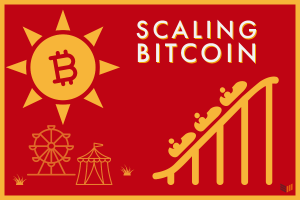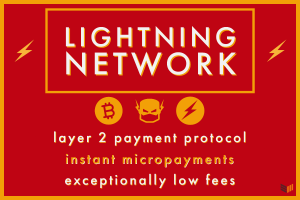
Previously, we talked about the bitcoin vs. bitcoin cash debate, where proponents of bitcoin cash argued that bitcoin isn’t scalable enough. Many people like to criticize Bitcoin’s limited network bandwidth by referencing payment processors like Visa and MasterCard, which process over 5000 transactions per second; in comparison, the Bitcoin network processes about five transactions per second.
There’s a valid concern here — how can bitcoin replace this existing payment network if it can’t even scale?
But the mistake people make is assuming that credit card processors act as payment settlement base layers. This is certainly not the case, and actual transaction settlements often take several days to resolve—instant credit card transactions are merely sitting on top.
So, why are people treating Bitcoin like a secondary payment layer when it’s really a base settlement layer?

Proposed Solutions
Numerous proposed solutions have been brought up over the years as the network continues to grow larger and larger. One such proposal is a conjunction system between the existing financial system and the Bitcoin network.
For a few brief decades from the late 1800s to the early 1900s, under the gold standard, banks held reserves in gold and handed out paper “certificates” or “bills” that represented an IOU to their gold reserves. To put it simply, people needed a way to pay in small denominations in a way that was easy to carry and store — they certainly weren’t going to run around cutting off little pieces of gold bars to exchange for groceries.
Under a similar hypothetical “bitcoin standard” we could hold bitcoin under custody and execute layered transactions as custodians batch them onto the blockchain. For instance, you can send bitcoin back and forth on CashApp for free, but you are not really “sending” bitcoin. Rather, you are receiving an IOU anytime someone pays you, and only when you transfer your bitcoin to your own wallet is when the transaction is confirmed on the blockchain.
There are other options like scaling via sidechains such as Blockstream’s Liquid, but the most popular in-use remedy at the moment is this layer 2 solution: the Lightning Network.

The Lightning Network
The Lightning Network was created in 2015, designed as a second layer protocol that would help scale bitcoin transactions in order to lower user fees and allow for instantaneous transactions.
When you transact with someone via Lightning, you only perform bitcoin base-layer transactions when opening and closing the channel. While the channel is open, you can send thousands of micro-transactions instantly with negligibly low fees (often less than a penny).
Additionally, you can send funds to those you aren’t directly connected to.
Imagine that you are back in primary school playing a game of telephone with your friends. In order for the person at the end of the line to receive the message, you need to whisper the message to the person next to you, who then passes it on to the person next to them, and on and on.
Since you’re not connected to the person on the end, you can’t just whisper the message to them — you need to pass it to someone else first. Lightning channels work similarly in that they can “pass on” transactions through shared channels, in a trust-less way. When you want to send a Lightning payment to a merchant, for instance, you don’t need to open a direct channel with them. Rather, the network finds the fastest route to channel your payment through, making the transaction process seamless and easy.
The Future of Scaling Payments
When bitcoin is realistically scaled, people won’t really need to know exactly how these payments are routed — just like how you probably don’t exactly know how your credit cards and wire transfer payments are settled. But, if Lightning is something that sparks a technical interest, you can read more on how it works here.
While Lightning is still a fairly new system, it’s developing at a fast pace. Already, it is being used practically en-masse for people to send tips or pay for consumer goods (like in El Salvador) instantaneously in bitcoin.
With solutions like Lightning, other altcoins such as litecoin or bitcoin cash that claim to solve the scaling problem are rendered inconsequential.
Bitcoin is a full on rainstorm, while fiat is a house of cards ready to collapse at any moment. As the world keeps their eye on Lightning and how it helps scale bitcoin in an entire small country, I only hope this will captivate the attention of other nation states to follow suit in adopting this sound, decentralized currency.
In this video, we explore how the lightning network makes Bitcoin scalable to a global audience.
The lightning network is a second layer that operates on top of the Bitcoin blockchain and anchors directly to it, allowing for millions of transactions per second and helping to solve Bitcoin’s scalability problem.
Watch Video
Confused? Have questions? Tweet them with #21DaysofBitcoin!